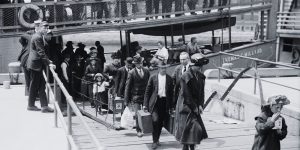What Happened On June 17th?
On a summer day, June 17, 1885, New York Harbor saw the arrival of the Statue of Liberty from France. The statue came in 350 pieces and was designed by French sculptor Frédéric Auguste Bartholdi. As a gift from France to celebrate the American Declaration of Independence’s centennial, the gift honored the enduring friendship between the two nations.
Liberty In Pieces
The statue was taken apart and packed into 214 crates for its voyage aboard the French ship Isère. The trip faced many challenges, including rough seas that threatened the cargo. Upon arrival in New York, a crowd of thousands gathered.
Piecing Together Freedom
People might have imagined that the statue would be met with immediate fanfare and celebration. However, the process was far from straightforward. The pedestal, which was to support the statue, was not yet completed. Fundraising for the pedestal faced numerous setbacks, leading to delays. Joseph Pulitzer, the influential newspaper publisher, gathered public support through a fundraising campaign in his newspaper, “The World.” Pulitzer’s appeal to ordinary citizens, asking them to contribute small donations, proved successful, showing the collective effort behind the statue’s installation.
Foundations Of Liberty
The pedestal itself, designed by American architect Richard Morris Hunt, was a masterpiece in its own right. Construction began in 1884 on Bedloe’s Island, later renamed Liberty Island, and continued while the statue made its journey across the Atlantic. When the crates arrived, they were stored in various locations around the island and in Manhattan, awaiting the completion of the pedestal.

Lady Liberty’s Puzzle
Workers began the painstaking task of reassembling the statue, guided by a 50-page instruction manual sent by Bartholdi himself. This manual was essential for the correct assembly of the 151-foot statue, ensuring that every piece fit perfectly. The iron framework, designed by Gustave Eiffel, the engineer behind the Eiffel Tower, provided the necessary support for the copper skin of the statue.
From Copper To Green
Did you know that the statue’s iconic green color was a result of the natural oxidation of its copper skin? The “green” was not present when it first arrived. The statue initially shone with bright, shiny copper, which gradually turned green over the next 30 years. This natural patina now serves as a protective layer, preserving the statue for future generations.
United Efforts
The reassembly of the statue was not just a feat of engineering but also a symbol of international cooperation and mutual respect. French artisans and American workers collaborated closely, overcoming language barriers and technical challenges. The process took several months, and on October 28, 1886, the statue was finally dedicated in a grand ceremony presided over by President Grover Cleveland.
Bartholdi’s Moment
During the dedication ceremony, Bartholdi climbed to the top of the statue to release a French flag that covered Lady Liberty’s face, revealing her to the cheering crowd below. The statue, officially named “Liberty Enlightening the World,” stood as a welcoming sight for immigrants arriving by sea.
The Torch’s Evolution
Another fascinating tidbit involved the statue’s torch, which underwent several changes over the years. The original torch, designed by Bartholdi, was replaced in 1916 due to extensive damage caused by weather and structural weaknesses. The new torch, covered in gold leaf, was installed to ensure its lasting brilliance. Today, the original torch is displayed in the statue’s pedestal museum.
Facing Sabotage and War
Despite its eventual completion and dedication, the Statue of Liberty faced continued challenges. During World War I, the statue became a target for German saboteurs. In 1916, an explosion on nearby Black Tom Island, a munitions depot, caused significant damage to the statue, shattering windows and causing the closure of the torch to visitors—a restriction that remains in place to this day.

Ellis Island & New Beginnings
During the late 19th and early 20th centuries, it became a symbol of hope for the millions of immigrants arriving in the United States. Ellis Island, the busiest immigrant inspection station, operated in the shadow of Lady Liberty, making the statue the first glimpse of America for many newcomers.
In modern times, the Statue of Liberty inspired millions of visitors each year. The statue’s story showed the efforts and contributions of countless individuals who came together to create a lasting symbol of freedom and democracy. Lady Liberty, as she gazed out over the harbor, stood not only as a beacon of hope to the world but also as proof of the enduring friendship between France and the United States, a bond that has lasted over time.





